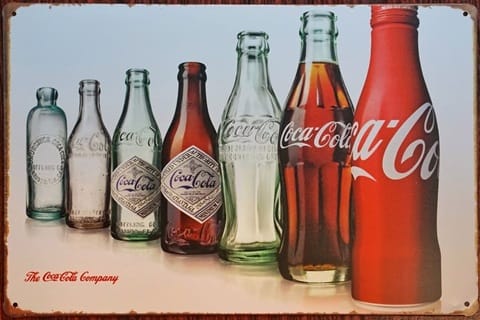
Coca-Cola’s story began in 1886 when pharmacist John Stith Pemberton formulated a unique, sweet beverage in his Atlanta-based laboratory, Pemberton Chemical Company. A Confederate Cavalry officer, Pemberton developed the formula while recovering from a severe wound sustained in a Civil War battle in Georgia. Struggling with chronic pain, he turned to morphine and eventually sought an alternative remedy—leading to the birth of Coca-Cola.
The original drink combined caffeine from the African kola nut with extracts from the coca leaf, a blend designed as a medicinal tonic. Marketed as a cure for ailments such as headaches, fatigue, and even impotence, Pemberton’s syrup was soon introduced to Jacob’s Pharmacy, where it was mixed with carbonated water. With the help of his business partner, Frank M. Robinson, the drink was given the name “Coca-Cola.” Robinson, known for his exceptional penmanship, also designed the now-iconic script logo.
Initially, Coca-Cola saw modest sales, averaging just nine servings per day in its first year. However, investors quickly recognized the beverage’s potential, setting the stage for global expansion.
The Branding Behind the Name
Pemberton’s bookkeeper, Frank Robinson, was responsible for both the brand name and its distinctive logo. Since the formula included coca leaf extract and kola nut caffeine, the name “Coca-Kola” seemed logical. However, Robinson believed that replacing the “K” with a “C” would make the name more visually appealing in advertising. The result was the now globally recognized Coca-Cola brand, complete with its elegant scripted logo.
The Rise of Coca-Cola Under Asa Candler
In 1887, Atlanta pharmacist and entrepreneur Asa Candler saw Coca-Cola’s potential and purchased the formula from Pemberton for just $2,300. Sadly, Pemberton passed away a few years later, but under Candler’s leadership, the brand took off. By the late 1890s, Coca-Cola had become one of America’s most popular fountain drinks, thanks to Candler’s aggressive marketing tactics. Between 1890 and 1900, syrup sales skyrocketed by over 4,000%.
Although Coca-Cola has long denied the claim, historical evidence suggests that until 1905, the drink contained trace amounts of cocaine. At the time, cocaine was not yet illegal, but by the early 1900s, Candler began phasing it out. By 1929, all psychoactive elements had been fully removed from the coca leaf extract.
How Coca-Cola Expanded Its Reach
Coca-Cola’s success can be largely attributed to strategic advertising. By the early 1900s, the company had expanded across the United States and Canada, licensing independent bottling companies to distribute the drink—a business model still in use today.
Before the 1960s, soda fountains in drugstores and ice cream parlors were the primary venues for Coca-Cola consumption. These establishments served as social hubs where people of all ages gathered. However, the rise of commercial ice cream, bottled beverages, and fast-food chains led to the decline of soda fountains.
The New Coke Controversy
On April 23, 1985, Coca-Cola made a bold move by introducing a new formula, dubbed “New Coke,” to counter declining sales in an increasingly competitive market. The change was met with immediate backlash. Fans strongly opposed the new taste, and within three months, the company reinstated the original formula, rebranded as “Coca-Cola Classic.” New Coke lingered until 1992 under the name Coke II before being discontinued in 2002.
Coca-Cola’s Cultural Impact and Advertising Legacy
By 2017, Coca-Cola had become a Fortune 500 company, generating over $41.3 billion in annual revenue with a workforce of 146,200 employees. The company’s products were being consumed at a staggering rate of over one billion drinks per day.
One of the most memorable advertising campaigns came in 1971 with the song “I’d Like to Buy the World a Coke.” Conceived by Bill Backer, the campaign initially struggled on the radio. However, Coca-Cola executives approved an unprecedented $250,000 budget for a television commercial, which turned the song into a cultural phenomenon. The campaign remains one of the most iconic advertisements of all time, even making an appearance in the 2015 series finale of Mad Men.
Coca-Cola and War Strategy
During World War II, Coca-Cola ensured its product was available to American troops worldwide. This strategic move dramatically increased demand, leading to a near doubling of international bottling facilities between the mid-1940s and 1960s.
Additionally, Coca-Cola introduced its second major beverage, Fanta, during this period. Originally developed for the German market, Fanta remains one of the company’s top-selling brands, consumed over 130 million times daily worldwide.

The Dark Side of Coca-Cola: Health and Controversies
Despite its global popularity, Coca-Cola has faced significant criticism. One of the most glaring issues is the impact of sugary sodas on public health. Studies have linked excessive consumption to obesity, diabetes, heart disease, and even cancer, as outlined by the Harvard School of Public Health.
Another controversy revolves around Coca-Cola’s environmental footprint. In India, the company has been accused of depleting local water supplies, especially during drought conditions, sparking nationwide protests.
Additionally, leaked emails suggest that Coca-Cola may have attempted to influence health policies by working closely with the Centers for Disease Control and Prevention (CDC). Critics argue that such lobbying efforts aim to downplay the negative health effects of sugary beverages to protect corporate profits.
Coca-Cola’s Controversies: Pollution, Exploitation, and Alleged Violence
A Major Contributor to Plastic Pollution
Coca-Cola has faced persistent criticism for its role in plastic pollution. As one of the largest producers of plastic packaging, it has been ranked among the world’s top plastic polluters for five consecutive years. Despite mounting pressure, the company has been accused of resisting significant investments in renewable or recycled materials, choosing instead to prioritize profits over sustainability.
Its sponsorship of the COP27 climate talks in Egypt was widely condemned as greenwashing—a strategic move to improve its public image while remaining a major player in the climate crisis.
Water Scarcity and Contamination in India
Coca-Cola’s environmental footprint extends beyond plastic waste. In India, the company has been accused of contributing to severe water shortages and contamination. At its peak, Coca-Cola operated over 58 bottling plants in the country, allegedly depleting groundwater supplies and exacerbating drought conditions.
The situation worsened in 2003 when India’s Central Pollution Control Board exposed a shocking revelation: waste from a Coca-Cola plant in Uttar Pradesh contained toxic heavy metals, including cadmium, lead, and chromium. Even more disturbing, Coca-Cola had been distributing this hazardous sludge to local farmers under the guise of “free fertilizer,” endangering both agriculture and public health.
Allegations of Union Suppression and Murder in Colombia
Perhaps the darkest chapter in Coca-Cola’s history unfolded in Colombia, where the company was accused of colluding with paramilitary death squads to silence labor unions.
In 2003, trade unions across the globe launched a boycott against Coca-Cola, alleging that the company’s bottling plant managers had hired right-wing militias linked to the United Self-Defense Forces of Colombia (AUC). The allegations were grave: union leaders were reportedly threatened, kidnapped, tortured, and even murdered to suppress labor movements. Within 13 years, at least nine union members were allegedly assassinated.
According to reports, Coca-Cola’s targeting of union members intensified during contract negotiations. The brutality extended beyond workers themselves—paramilitary forces allegedly kidnapped and tortured a 15-year-old son of a union activist, while another union member’s brother was murdered.
A Legacy of Contradictions
Despite these controversies, Coca-Cola remains one of the world’s most influential brands, shaping global culture and consumer habits for over a century. While its impact on communities and the environment raises serious concerns, its contributions to advertising, business, and even moments of nostalgia cannot be ignored.





